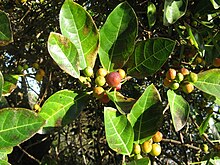
Ficus macrophylla, commonly known as the Moreton Bay fig or Australian banyan, is a large evergreen banyan tree of the Mulberry Family (Moraceae) native to eastern Australia, from the Wide Bay–Burnett region in the north to the Illawarra in New South Wales, as well as Lord Howe Island where the subspecies F. m. columnaris is a banyan form covering 2.5 acres or more of ground. Its common name is derived from Moreton Bay in Queensland, Australia. It is best known for its imposing buttress roots.

Ficus rubiginosa, the rusty fig or Port Jackson fig, is a species of flowering plant native to eastern Australia in the genus Ficus. Beginning as a seedling that grows on other plants (hemiepiphyte) or rocks (lithophyte), F. rubiginosa matures into a tree 30 m (100 ft) high and nearly as wide with a yellow-brown buttressed trunk. The leaves are oval and glossy green and measure from 4 to 19.3 cm long and 1.25 to 13.2 cm wide.

Cauliflory is a botanical term referring to plants that flower and fruit from their main stems or woody trunks, rather than from new growth and shoots. It is rare in temperate regions but common in tropical forests.

Ficus tinctoria, also known as dye fig, or humped fig is a hemiepiphytic tree of genus Ficus. It is also one of the species known as strangler fig.
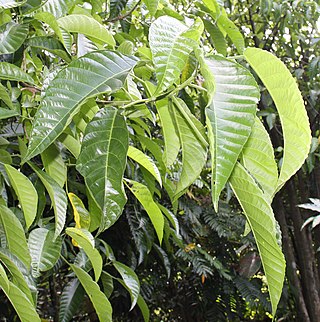
Dendrocnide is a genus of approximately 40 species of plants in the nettle family Urticaceae. They have a wide distribution across North East India, Southeast Asia, Australia and the Pacific Islands. In Australia they are commonly known as stinging trees.
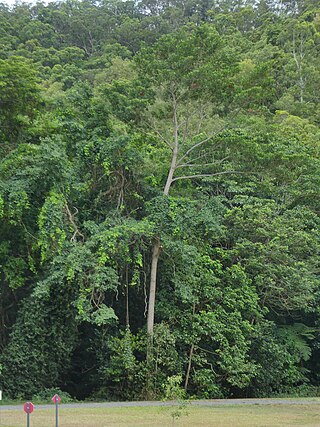
Elaeocarpus grandis, commonly known as the blue quandong, silver quandong or blue fig, is a species of flowering plant in the family Elaeocarpaceae which was first described in 1860. It is a large buttressed tree native to the coastal rainforests of northeastern Australia. The validity of this taxon is disputed, with some authorities accepting it and others presenting it as Elaeocarpus angustifolius.
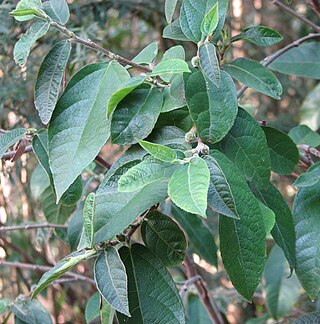
Ficus coronata, commonly known as the sandpaper fig or creek sandpaper fig, is a cauliflorous species of fig tree, native to Australia. It is found along the east coast from Mackay in Central Queensland, through New South Wales and just into Victoria near Mallacoota. It grows along river banks and gullies in rainforest and open forest. Its common name is derived from its rough sandpapery leaves, which it shares with the other sandpaper figs.

Ficus obliqua, commonly known as the small-leaved fig, is a tree in the family Moraceae, native to eastern Australia, New Guinea, eastern Indonesia to Sulawesi and islands in the southwestern Pacific Ocean. Previously known for many years as Ficus eugenioides, it is a banyan of the genus Ficus, which contains around 750 species worldwide in warm climates, including the edible fig. Beginning life as a seedling, which grows on other plants (epiphyte) or on rocks (lithophyte), F. obliqua can grow to 60 m (200 ft) high and nearly as wide with a pale grey buttressed trunk, and glossy green leaves.
The sandpaper figs are so named for their leaves, which are rough and sandpaper-like in texture. The common name may refer to a number of species in the genus Ficus:

Alpinia caerulea, commonly known as native ginger or Australian ginger, is an understorey perennial herb in the family Zingiberaceae which grows in rainforest, gallery forest and wet sclerophyll forest in eastern Australia.
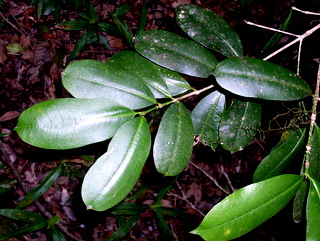
Baloghia inophylla, commonly known as the scrub bloodwood, brush bloodwood or ivory birch, is a plant in the spurge family Euphorbiaceae, native to rainforests of eastern Australia and New Caledonia.
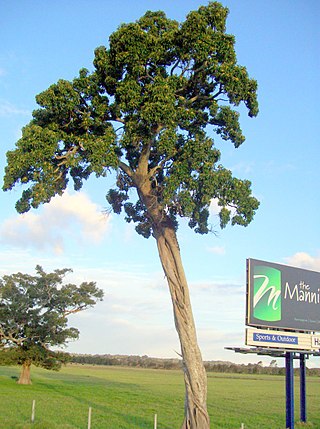
Ficus henneana is a strangler fig only occurring in Australia. Previously considered a variety of Ficus superba which occurs in China, Japan and parts of South East Asia. The cedar fig or deciduous fig grows in Australia from Milton, New South Wales to northern Queensland and the Northern Territory. The habitat is riverine, littoral or the drier forms of rainforest. The fruit is considered edible for humans, but it is not particularly palatable.
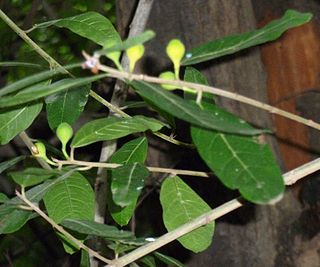
The river sandpaper fig is a fig shrub or small tree of the western and eastern Afrotropics. It is typically found around pans or flood plains, or along riparian fringes in tropical or subtropical savanna regions, but is absent from the tropical rainforest zone. Despite its regular scrambling habit it may attain a height of 7 to 10 m.

Ficus coronulata, commonly known as the peach-leaf fig, and in the Northern Territory as river fig and crown fig, is one of several fig species commonly known as sandpaper figs. It is native to Western Australia and the Northern Territory.

Maireana pyramidata is a species of plant within the genus, Maireana, in the family Amaranthaceae. It is endemic to Australia, and widespread throughout Australia in the inland, where it is found in Victoria, New South Wales, Queensland, the Northern Territory and Western Australia.

Lawrencia squamata is a species of plant in the mallow family, Malvaceae. It is endemic to Australia and occurs in all Australian states.
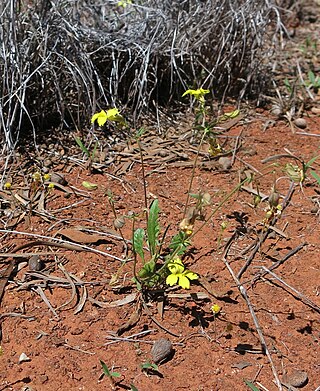
Velleia glabrata is an annual herb in the family Goodeniaceae, which is native to all mainland states and territories of Australia with the exception of Victoria. It grows on sand and clay, flowering from June to October.
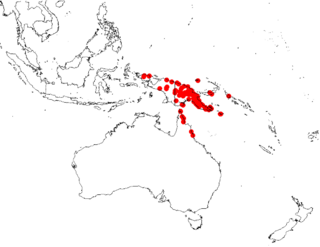
Decaisnina hollrungii is a species of flowering plant, an epiphytic hemiparasitic plant of the family Loranthaceae native to the New Guinea, Queensland, Australia, and in the Bismarck Archipelago and the Solomon Islands.

Elatostema reticulatum, commonly known as rainforest spinach, is a plant in the nettle family Urticaceae endemic to eastern areas of Queensland and New South Wales. It is a course straggly herb growing to 50–100 cm (20–39 in) high, and may form dense mats on the forest floor. It prefers wet shaded areas in rainforest and wet sclerophyll forest, and is often found in and beside streams as well as on wet rock faces. The natural range of the plant is from near Batemans Bay in the south to the ranges and tablelands near Cairns in the north.
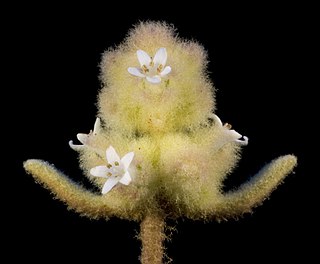
Dicrastylis brunnea is a species of plant within the genus, Dicrastylis, in the family Lamiaceae. It is endemic to the south-west of Western Australia.
